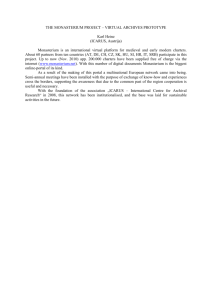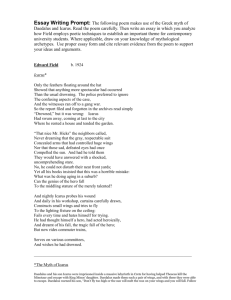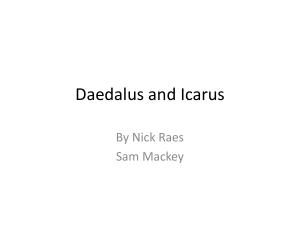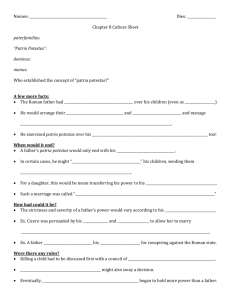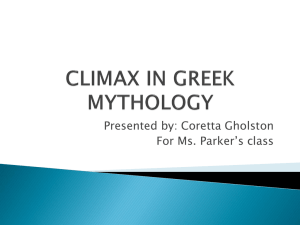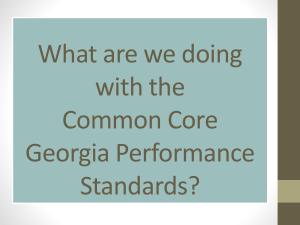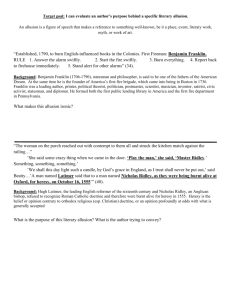Holly Brewer - URI-EnglishLanguageArts
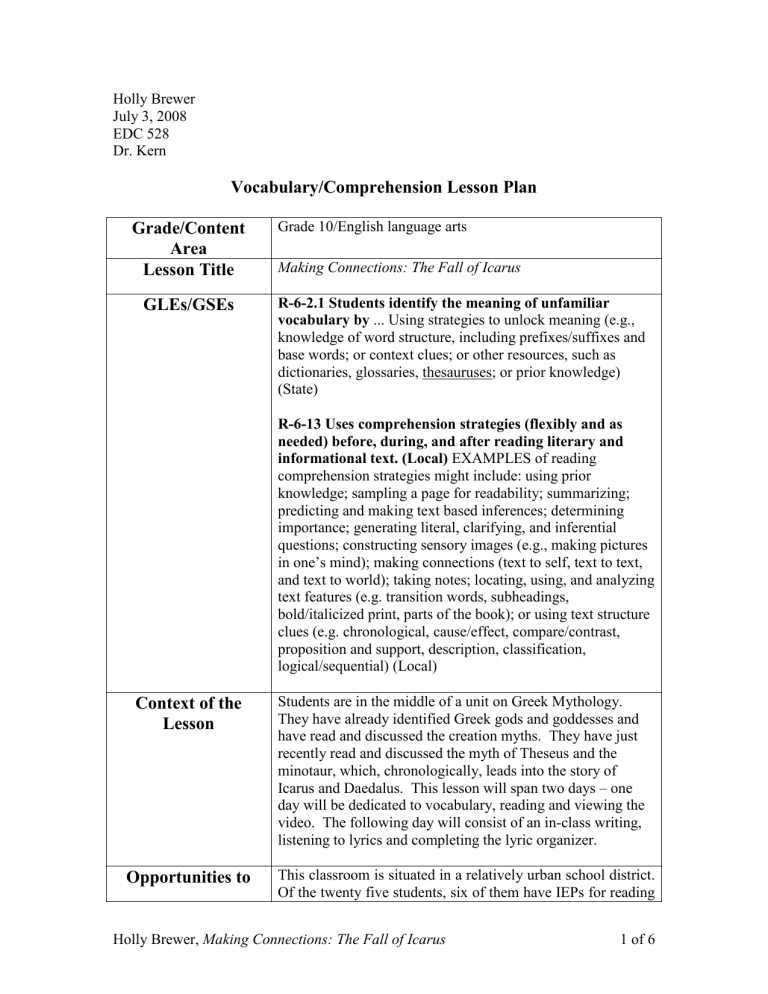
Holly Brewer
July 3, 2008
EDC 528
Dr. Kern
Grade/Content
Area
Vocabulary/Comprehension Lesson Plan
Grade 10/English language arts
Lesson Title
Making Connections: The Fall of Icarus
GLEs/GSEs
R-6-2.1 Students identify the meaning of unfamiliar vocabulary by ... Using strategies to unlock meaning (e.g., knowledge of word structure, including prefixes/suffixes and base words; or context clues; or other resources, such as dictionaries, glossaries, thesauruses; or prior knowledge)
(State)
R-6-13 Uses comprehension strategies (flexibly and as needed) before, during, and after reading literary and informational text. (Local) EXAMPLES of reading comprehension strategies might include: using prior knowledge; sampling a page for readability; summarizing; predicting and making text based inferences; determining importance; generating literal, clarifying, and inferential questions; constructing sensory images (e.g., making pictures in one’s mind); making connections (text to self, text to text, and text to world); taking notes; locating, using, and analyzing text features (e.g. transition words, subheadings, bold/italicized print, parts of the book); or using text structure clues (e.g. chronological, cause/effect, compare/contrast, proposition and support, description, classification, logical/sequential) (Local)
Context of the
Lesson
Students are in the middle of a unit on Greek Mythology.
They have already identified Greek gods and goddesses and have read and discussed the creation myths. They have just recently read and discussed the myth of Theseus and the minotaur, which, chronologically, leads into the story of
Icarus and Daedalus. This lesson will span two days – one day will be dedicated to vocabulary, reading and viewing the video. The following day will consist of an in-class writing, listening to lyrics and completing the lyric organizer.
Opportunities to
This classroom is situated in a relatively urban school district.
Of the twenty five students, six of them have IEPs for reading
Holly Brewer, Making Connections: The Fall of Icarus 1 of 6
Learn
Objectives
difficulties and/or attention issues. For these students, and all other students, the one hour and fifteen minute class block will be divided into four short activities. Photocopies of the myth and lyrics, as well as links to the youtube video will be available for classroom, resource and home use. Dictionaries will also be available as needed.
This lesson includes opportunities for students to learn in all three modalities. Students with visual strengths will benefit from the youtube video and the graphic organizers. Students will auditory strengths will also benefit from the youtube video, as well as the opening read-aloud and listening to the song “Carry on Wayward Son.” Students with kinesthetic strengths will benefit from the hands-on lyric exercise as well as the use of graphic organizers.
Materials:
Martin, Richard P. Myths of the Ancient Greeks. New York:
Penguin Books Ltd, 2003.
Kansas. “Carry on Wayward Son,” 1976.
Handouts – photocopy of Icarus myth, Janet Allen’s
“Contextual Redefinition” graphic organizer, Kansas lyrics,
Venn Diagram graphic organizer
Greek mythology binders
Scissors
Glue
Technology:
Students will watch a cartoon version of the myth of Daedalus and Icarus from: http://www.youtube.com/watch?v=le8BzGMsGtU .
Afterwards, they will listen to the song Carry on Wayward
Son by Kansas.
The student will learn to utilize context clues to understand new vocabulary terms, specifically in the myth of Icarus and
Daedalus.
The student will make connections between the myth of
Icarus and Daedalus and the lyrics to “Carry on Wayward
Son.”
Holly Brewer, Making Connections: The Fall of Icarus 2 of 6
Instructional
Procedures
Opening:
Today, we are going to move forward into Greek mythology and read about Daedalus, a Greek engineer, and his son
Icarus. But, before we meet the two of them, let’s recap yesterday’s myth about Theseus and the minotaur.
Students are asked to open their Greek mythology binders, which include all myths and graphic organizers discussed to date. Quickly, the teacher asks volunteers to share a part of yesterday’s myth with the rest of the class in order to prepare for today’s lesson.
In today’s lesson, we are going to read about Daedalus and
Icarus. Then, we are going to make connections to modern day popular culture by viewing a youtube cartoon and by listening to a rock song.
Engagement:
DAY 1
Before we begin reading the myth of Daedalus and Icarus, let’s take a look at the vocabulary in the text.
Pass out a copy of Janet Allen’s “Contextual Redefinition” with words from the myth.
Take a look at this graphic organizer.
Read instructions aloud.
Work with a group to make predictions for definitions of each of the following words. The words included here are found in the myth of Daedalus and Icarus. Remember that some words which look familiar will probably have new meanings in this context. Anyone have questions as to what I’m asking you to do here? Please pair up with the person next to you and take a few minutes to fill out this sheet.
Students work together to complete graphic organizer.
Afterwards, teacher breaks up groups and quickly goes over the organizer as a class.
Ok, time to find out what happens to the minotaur.
Teacher passes out copies of the myth then begins a read aloud, reading the first paragraph then asking for volunteers to read the following paragraphs.
Now, let’s take a look at a cartoon version of the story. While you are watching, jot down similarities and differences between the text version and the cartoon version on a scrap piece of paper.
Begin youtube video.
We’re out of time for today, but, for homework, think about the similarities and differences between the text and the video.
We will begin class tomorrow with an in-class writing.
Holly Brewer, Making Connections: The Fall of Icarus 3 of 6
DAY 2
So, what did you think of yesterday’s video? Were there a lot of similarities? Did you like the cartoon? Did you think it was an accurate representation? Why or why not? Using your notes, take a few minutes to discuss these questions in the writers section of your binder.
Teacher, before class begun, had already written the questions on the board so students can see the questions while they are writing.
Anyone want to share their answers?
Teacher gives students the opportunity to share their writing assignments and opens a short discussion.
Now, we are going to continue to work with making connections. This time, we are going to turn to music.
Teacher passes out lyrics handout.
Kansas, a famous 1970s rock band, sang this song “Carry on
Wayward Son.” Please listen to the song and, as you did yesterday with the cartoon, jot down some similarities and differences between the text and the lyrics.
Teacher plays song for class then, when song is over, passes out Venn Diagram graphic organizer.
Now, we’ve worked with Venn Diagrams in the past, right?
Anyone want to share with us exactly how this works?
Asks for a volunteer to share directions. If no one volunteers, teacher explains.
Here is your assignment: Take the lyrics I gave you for
“Carry on Wayward Son” and cut them up into phrases. For example, I would cut out the lyrics “Once I rose above the noise and confusion” and “I was soaring ever higher, but I flew too high.” You should cut these and at least four others out. Then, think back to your text and come up with six phrases that describe the text. Then, write them on a piece of scrap paper. For instance, I would write “Daedalus created wings with wax” and “Icarus flew too high to the sun.” You may use these, then come up with four more of your own.
Then, when you have your lyrics cut out and your text phrases done, you can begin to complete your Venn Diagram. Label the left circle “Lyrics” and the right circle “Text.” Take your six lyric phrases and your six text phrases and complete the graphic organizer. When you are finished, share your diagram with your neighbor and discuss your decisions.
Give students about fifteen to twenty minutes to complete organizers and discuss with neighbor.
Holly Brewer, Making Connections: The Fall of Icarus 4 of 6
Assessment
Reflections
(no work submitted to date)
Closure:
Now that you’ve completed your diagrams and discussed with a neighbor, let’s come together whole class to discuss the activity. Did you make a lot of connections between the text and the lyrics? Did you feel that knowing the myth before hearing the song was beneficial to the understanding of the song? Why or why not?
For tomorrow, I would like you to find another popular culture connection to the myth of Daedalus and Icarus. You may look online, either here at school or at the local library, to find music, art, or film that references the myth we read yesterday.
Your assignment is to bring in a copy of the pop culture connection you found. You may bring in lyrics, a movie synopsis from IMDB.com or a printed copy of the artwork.
Be prepared to discuss the connection between the two in an in-class writing tomorrow.
1.
Collect “Contextual Redefinition” vocabulary graphic organizer, informally assessing their abilities to use context clues.
2.
Collect in-class writing and assess as one of many inclass writing exercises on Greek Mythology.
3.
Collect lyric Venn Diagram for participation points after discussing the connections as a whole class activity.
Homework: Ask students to go online to find another popular culture connection (music, art, film etc.) to the story of
Daedalus and Icarus. Ask students to bring in their examples
(lyrics, movie synopses, artwork, etc.) to share with the class.
Student Work Sample 1 – Approaching Proficiency:
Student Work Sample 2 – Proficient:
Student Work Sample 3 – Exceeds Proficiency:
Lesson Implementation:
Holly Brewer, Making Connections: The Fall of Icarus 5 of 6
Carry On Wayward Son
(Kerry Livgren)
CHORUS:
Carry on my wayward son
For there'll be peace when you are done
Lay your weary head to rest
Now don't you cry no more
Once I rose above the noise and confusion
Just to get a glimpse beyond the illusion
I was soaring ever higher, but I flew too high
Though my eyes could see I still was a blind man
Though my mind could think I still was a madman
I hear the voices when I'm dreamin'
I can hear them say
CHORUS
Masquerading as a man with a reason
My charade is the event of the season
And if I claim to be a wise man, it surely means that I don't know
On a stormy sea of moving emotion
Tossed about, I'm like a ship on the ocean
I set a course for winds of fortune, but I hear the voices say
CHORUS
Carry on, you will always remember
Carry on, nothing equals the splendor
Now your life's no longer empty
Surely heaven waits for you
CHORUS
*www.elyrics.net*
Holly Brewer, Making Connections: The Fall of Icarus 6 of 6
